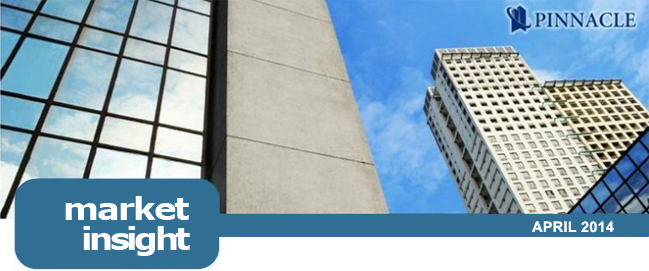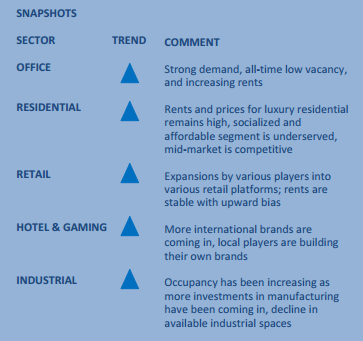
SPOTTING MARKET GAPS
The Economy

Philippines’ full year target for 2014 is between 6.5-7.5% growth, on the back of the 7.2% real Gross
Domestic Product (GDP) growth in 2013 even with the impact of the natural disasters, according to
National Economic and Development Authority (NEDA). The International Monetary Fund (IMF) pegged
the average GDP growth rate for most of the members of the Association of Southeast Asian Nations
(ASEAN) at 5.1% this year, which is lower than the Philippines’ target. The IMF projected the world’s
growth at 3.1% for 2014.
Based on Bangko Sentral ng Pilipinas (BSP) statistics, the average bank interest rate continues to dip at
5.19% as of February of this year compared to 6.21% by the end of 2013. Inflation rate by February is
4.1% compared to 2.9% by end 2013. Given the brisk economic activities, especially in manufacturing
and real estate, the BSP recently increased the reserve requirement ratio by 1 percentage to 8% across
all banks. This move has been expected to avoid overheating of the economy and to curb speculation,
especially in the real estate market.
The Philippine Peso to US Dollar exchange shows a stronger dollar from Php 41.2 by end 2013 to Php
44.9 by end March 2014. This indicates that the US economy has been steadily improving since dollar
remittances from overseas Filipinos have been stable and reached US$22.97 billion by end of 2013. For
January of this year, overseas Filipino remittances total to US$1.80 billion compared to US$1.70 billion
for the same period last year.
The total Visitor Arrivals last year was a record breaking 4.68 million, which is 9.56% higher than 2012.
Visitor Arrivals in January of this year increased by 5.8% to 461,363 from 436,079 in the same month
last year. The government is targeting a total Visitor Arrivals of six million this year.
Foreign direct investment (FDI) has been dominated by
manufacturing investments and real estate activities,
outside of debt instruments and reinvested earnings.
Manufacturing comprised 51% of the total foreign direct
investments in 2012 and 33% in 2013. Real estate activities
account for 8.2% in 2012 and 10.6% in 2013.
These key economic statistics indicate a sustained economic
growth and sound investment environment for 2014. All
indicators point to another banner year for the real estate
industry. While some quarters are getting uncomfortable
with the very active industry, even prompting the BSP to
increase reserves, thereby withholding approximately Php
60 billion to the financial market, the real estate market is
basically becoming more competitive. This is an excellent
prelude to prepare the industry with the upcoming ASEAN
integration by 2015.
Most people would prefer a competitive market. This would
reduce inefficiencies and would promote good product and
pricing for the consumers. Now more than ever, real estate
players should be able to spot market gaps, ahead of the
other players if possible. Developers cannot anymore rely on
the “build it and they will come” mantra as buyers have
more choices and are more discerning. Misreading the
market would be costly. Diligent players should be patient
and deliberate with their target location, target product,
target market and target timing. Spots of opportunities are
present in the ever-increasing real estate market, whether
redevelopment projects within Metro Manila or green field
developments outside. Within the sectors of the real estate
markets, gaps are still waiting to be serviced. More
importantly, the government has been active in building
crucial infrastructure projects, and in generating tourist
arrivals and investors that would translate to real estate
demands.

Office Market
The Business Process Outsourcing (BPO) industry remains
the driver of the demand for office spaces not only in Metro
Manila but the entire Philippines. After experiencing more
than 20% annual average growth in the past 10 years,
industry estimates point to a slower 15% annual growth
beyond 2016. For 2014 and 2015, the average of 20%
growth is still doable. At present, vacancy of Premium Grade
A and Grade A buildings is at all-time low of below 5% across
the major business districts. Grade B and C buildings may
have higher vacancy levels, but these buildings would
eventually absorb the overspill of demand for office. Some
of these buildings may even be up for redevelopment,
whether into an office, residential or mixed used building.
Big space users have been committing to pre-leasing
agreements to avoid the space crunch. In recent months,
pre-selling of office spaces have been picking up, which used
to be unheard of after the Asian financial crisis in 1997.
Rents in Premium Grade A are higher than Php 1,000 per
sqm per month, while rents in Grade A have an average of
Php 750 per sqm per month. Small and old buildings in
Makati are offering rents at an average of Php 550 per sqm
per month. Depending on the vacancy of the buildings, rents
are projected to increase between 3%-7% this year.
There are a lot of opportunities in the office market.
Developers are now more confident building office buildings
since they can get pre-commitments. Owners of old
buildings may consider capturing the demand by retrofitting
their facilities; or they may consider redeveloping
altogether. Joint developments with building owners, even
with condominium corporations, are becoming common
especially when they don’t want to sell the land or would
want to share on the upside of the development. For
straight-forward office projects, developers may opt to sell
to recoup their investment faster, or may choose the
recurring income. In most cases, developers would want to find the balance between selling some floors
and retaining some floors for leasing; except for Zuellig Building which is purely for leasing.
Residential Market
The residential market shall continue to be very active given that the demand for housing is
projected at 3.9 million, and possibly reaching 6 million in the next few years without serious intervention. The mid-market has been the center of discussion due to the hyper activity in this segment, and some are even
asking the question of property bubble, especially in Metro Manila.
The Housing and Land Use Regulatory Board (HLURB) and Pinnacle Research statistics show that from
2013 to 2017, there are 301 ongoing condominium projects in Metro Manila totaling to 134,421 units.
The mid-market segment accounts for the largest chunk at 37% or 49,997 units. Studio and one-bedroom units account for 77% or 104,028 units. Assuming that all of these projects are completed on
time, these numbers are still well below the target of one million housing units by 2016 of Subdivision
and Housing Developers Association, Inc. (SHDA) to bridge the gap in housing requirements.
The high-end segment continues to be vibrant, especially with the sales abroad and to foreigners. This
segment is only the active segment in leasing, with rents well above Php 200,000 per month, depending
on the sizes. Rents in the villages generate the highest levels ranging from Php 300,000 to Php 500,000
per month.
The affordable and socialized segments are still underserved. Based on the same database above, only
24,981 units are targeting these two segments in Metro Manila. This is understandable since majority of
the socialized and economic housing projects are located outside Metro Manila to take advantage of
lower land prices.
Retail Market
Developers are relentless in having a piece of the
retail market, exploring various retail platforms,
setting up their own retail brands or forging alliance
with well-known local and international retailers.
DoubleDragon Properties Corp., the group that owns
Jollibee and Mang Inasal among others, intends to put
up 100 CityMalls with an aggregate space of about 1
million sq.m., by 2020. CityMall will be constructing
community centers of 5,000-10,000 sq.m., in sizes
that target to serve the provinces. In a strategic move,
the SM Group bought 34% into CityMall Commercial
Center, Inc., the retail company of the DoubleDragon
Group.
The SM Group is pursuing expansion this year with 20
supermarkets and three shopping malls. Robinsons
Group recently opened two full service malls, the
Robinsons Place Roxas in Panay Island, and Robinsons Place Santiago in Isabela, expanding to a total of
37 shopping centers nationwide. Its Ministop operations, a franchise of the Japanese brand, target to
reach over 500 stores by yearend.
Rustan’s Supercenters Inc. is expanding its operations by adding 13 more branches by the end of 2014.
The Ayala Group has been busy introducing its new mall brand “District” in Imus and Dasmariñas,
Cavite, and in Bacolod. Filinvest Group’s Festival Supermall started its four-level mall expansion with
“River Park” that would feature foreign fashion brands. The Century Property Group recently opened its
Century City Mall in Makati.
Super 8 Retail Systems is investing about Php 1.5 billion to hit a total of 75 stores within the next three
years. It also acquired America’s leading convenience store “Circle K” to add to the group’s retail
platform in servicing the consumer goods market in the country.
Major retailers shall continue enjoying high lease rates and occupancy levels. Malls are expected to
generate the highest yields in the real estate market. It is projected that more innovations in retail
platforms by both retailers and niche players would continue to service the untapped segments in the
market that would reach to the most number of Filipino shoppers.
Hotel and Gaming Market
Last year was a banner year for Visitor Arrivals reaching 4.68M. January data shows it is higher than the
arrivals for the same month last year. The hotel market shall continue to benefit from the steady rise of
the Philippine tourism industry and the ASEAN integration. In addition, the government signed an
additional air-link agreement with Japan that would increase weekly flights from 119 to 400. The
Department of Tourism (DOT) is projecting an increase of 15%-20% of Japanese travelers coming in. Last
year, a total of 433,705 Japanese visited the Philippines.
In terms of room rates, five star hotels are charging north of US$ 300 per night on the average. Four star
hotels have breached the US$ 250 rate on the average. Existing hotels have been enjoying increasing
rates due to record-breaking tourist arrivals.
On the supply side, about 4,000 rooms are targeted to be completed this year. The major chunk would
be in the PAGCOR Entertainment City area, such as Belle Grand City of Dreams (920 rooms), Radisson
Hotel (500 rooms) and Tune Hotel (204 rooms).
The Robinsons Group aims to complete 1,200 rooms in its portfolio this year with three Go Hotels
located in Ortigas Center, Butuan and Iloilo. In addition, the Group also signed with Singapore-based
Vanguard Hotels Pte. Ltd. and Roxaco Land Corp. to construct at least five Go Hotels in the next two
years.
The Ayala Group has launched two new Seda hotels in its emerging mixed-use developments in Vertis
North and Circuit Makati, and may take three years to complete.
Shanghai-based Jin Jiang International Hotels is putting its flag in Makati (70 rooms) and Ortigas Center
(95 rooms). Jin Jiang Inn Greenbelt and Jin Jiang Inn Ortigas are targeted for completion this year. More
and more international hotel operators are expanding their brands in the Philippines like Ascott, Conrad
Hotels and Resorts, Crowne Plaza, Dusit Thani, Fairmont, Hyatt, Holiday Inn, Intercontinental, Mandarin,
Marco Polo Hotels, Marriot, Maxims, Oakwood, Peninsula, Radisson, Renaissance, Shangri-La Hotels and
Resorts, Sheraton Hotels and Resorts, and Solaire Resort and Casino.
Industrial Market
The manufacturing sector continues to generate a significant chunk of foreign direct investments. For
2013, manufacturing accounts for US$216.41 million, second only to the new category of “Water
Supply; Sewerage, Waste Management and Remediation Activities” that accounts for US$ 461.38
million. This is one of the reasons why the growth of the manufacturing sector reached 12.3% in the
fourth quarter of 2013, making it the fastest growing industry in the Philippines during the quarter, and third overall for 2013. Manufacturing sector’s full year growth of 10.5% is nearly double the 2012
growth of 5.4%.
The Philippine Economic Zone Authority continues to promote the establishment of economic zones
due to decreasing vacancies in existing PEZA site. The combined available industrial space in Clark
Special Economic Zone (CLARK) and the Subic Bay Freeport Zone (SUBIC) is at a historic low of 150
hectares. CLARK has been filled up by 1,100 locators while SUBIC has a total of 600 locators.
Another sign of a healthier manufacturing sector is the recent purchase by Mitsubishi Motors
Philippines Corp. (Mitsubishi) of the 21-hectare non-operational manufacturing plant in Sta. Rosa,
Laguna. Mitsubishi is committed in expanding its sales and production capacity which is part of its new
stage of growth mid-term plan until the end of 2016 fiscal year.
OPPORTUNITIES IN MARKET GAPS
The office market remains to be a favorite given the high occupancy rate and an average yield of 10%.
Developers and landlords should take advantage of pre-leasing and pre-selling. Owners of old buildings
would have to decide sooner or later if they want to retrofit their buildings to capture the pent-up
demand for office, or redevelop their buildings altogether.
Commercial spaces in retail malls shall continue to generate the highest yields to the big retail owners.
For niche players, they should consider location-specific opportunities, especially for smart shoppers
that avoid long queues and tight parking in malls, and prefer relaxed shopping and dining.

The residential sector is a very big market. Luxury segment on one end and the affordable and socialized
housing on the other end remain to be underserved. Luxury is typically more expensive to build but the
margins are higher. Socialized and economic housing projects have lower margins on per unit basis, but
developers may get a number of fiscal and non-fiscal incentives that would push profitability higher.
Mid-market is very competitive and location-specific. This is the segment where due diligence would
pay off in terms of market scanning the sizes, amenities and prices of the residential products to be
offered; and perhaps, how much retail and office spaces to be blended in the mix. The leasing out of
mid-market residential is another gap in the market that may need to be served soon.
The hotel sector is riding on the investment grade status of the Philippines and record tourist arrivals.
The ASEAN integration and the increased in air-link with Japan would further boost the total number of
visitors. Finding the right location, the right size, right brand are some of the key questions for
developers.
The industrial sector is in a stable growth as more and more foreign companies and investors have been
coming back to the Philippines. Applications to get PEZA accreditation to locate in economic zones and
even to build new ecozones are on the rise as well.
The Philippines is poised to sustain the growth in the real estate market. All of the sectors are on
expansion mode due to real demand, liquid financial market and strong economy. Positive business
climate and servicing the market gaps would likely be a continuous boon to diligent actors in the
property market.
Download the PDF Version


